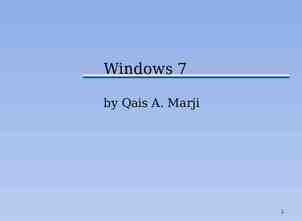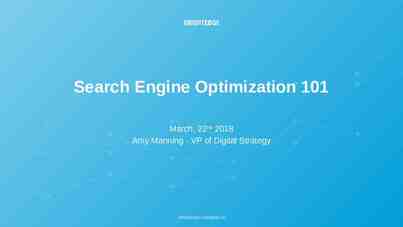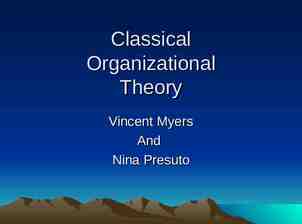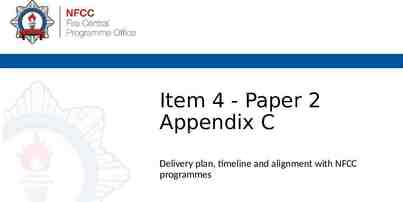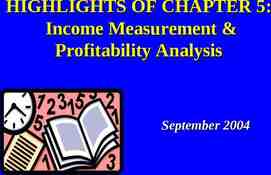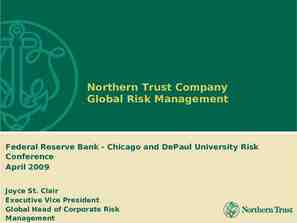SST/RTI Teacher Presentation Presented by Cameryn Rivers 2015 -2016 SY
26 Slides2.43 MB

SST/RTI Teacher Presentation Presented by Cameryn Rivers 2015 -2016 SY

The SST/RTI Pyramid

There’s that pyramid again

HUH?

SST/RTI in Layman’s Terms Intense interventions and potential evaluation. Instruction with interventions Effective classroom instruction

What is RTI? A Response to Intervention process: includes all students is designed as a proactive approach for instruction and intervention A flexible process that changes with the student is the responsibility of all certified staff and other instructional support staff 8

Tier 1 Instruction Tier 1 Instruction is for ALL Students Tier 1 Instruction should be consistent across ALL schools This is the beginning of the RTI process The RTI process begins with: Research-Based, Highly Engaging Instruction. What do we have without this in every classroom?

What does Tier 1 look like? Delivery of the intended curriculum! Standards Based Differentiated Engaging To Students Uses Formative and Summative Assessments College and Career Readiness Aligned to CCGPS Universal Screening

What is Tier 2? Tier 2 is defined as small group instruction that relies on researchbased interventions. Tier 2 has three characteristics that distinguish it from Tier 1 instruction: The goal of Tier 2 is to remediate academic skill deficits so students will be successful in the Tier 1 program without support. It is research (evidence)-based It consists of small-group instruction It involves a clearly articulated intervention implemented with fidelity

Reminder about Tier 2 Interventions In Addition to Tier 1! For small groups of students Focus on Gaps Are delivered at the Instructional Level of the Students (not Grade Level!) Needs that should be addressed within the next 4-9 weeks. Students should not receive more than 1 math intervention or more that 1 reading intervention at a time. Data is collected on a regular basis to determine if an intervention should be continued, altered or replaced

Who, When, Where, How? Which Students When/Where How Often Who All students within the school or grade band who need help with reading fluency may be grouped together. *Remember, can not be in place of instruction! Before school Extended Learning times Built in RTI block Lunch and Learn After School Programs EIP/REP *Best Practice – Tier 2 interventions occur at least twice per week for at least 20-30 min. It must be consistent. Classroom teacher *Students should be grouped based on instructional need, not necessarily by grade level, teacher, etc. *Remember, the aforementioned places and times are NOT interventions! The intervention is what is provided during these times ie: Every Monday 9-9:30 Every day at 10am for 20 min Every Mon, Wed, Fri from 2:30-3:00 *However, data depends on frequency of intervention. If intervention only occurs once a week then PM every month. If daily, may need to PM every week. *Often, schools will designate specific teachers with the ability to assist students with a specific need. *If classroom teacher, be sure he/she focuses on the instructional need versus reteaching the intended curriculum.

How does Tier 2 instruction differ from Tier 1 instruction? Tier 2 instruction is more explicit, systematic, intensive, and supportive with struggling learners receiving more instructional time (e.g., an additional 30 minutes) than just regular Tier 1 classroom reading instruction. Tier 2 is conducted with small, same-ability groups within or outside the classroom setting. Tier 2 instruction involves frequent progress monitoring to track student progress and inform instruction. During lessons, monitor students’ understanding and mastery of targeted objectives/standards Provide additional support. DON’T WAIT (Make adaptations to Tier 2 lessons)

Progress Monitoring Valid and Reliable Instrument Beginning at Tier 2, All Interventions must be Formally Assessed Used to determine the effectiveness of intervention Progress is measured regularly Rates of improvement or cut scores are identified Sensitive to small increments of growth The purpose of a Progress Monitoring Assessment is to Determine Intervention Effectiveness. Progress monitoring examines student growth over time on a specific concept All teachers monitor the progress of their students on a daily basis through formal and informal assessment .intervention progress monitoring is the same idea, but must be separate from class assessments.

Progress Monitoring Examples: Weekly 1 minute fluency checks Non-Examples: Chapter Tests Quizzes Bi-weekly 2-5 minute digit fluency checks A short assessment on comprehension every 2 weeks to determine if the intervention is working. What to use for PM – EASY CBM, Intervention Central, Etc. 16

How to Know if an Intervention is Working How do you know that an intervention needs to be changed or replaced? A lack of progress on PM assessments will let us know (this could take weeks!) Obvious that the wrong instructional level was used How can an intervention be changed? More Time More Frequent Different grade level Before deciding if an intervention should be changed or simply replaced with a different intervention, ask yourself these questions . Is progress being made? Would a different intervention help make progress faster?

Tier 3 In addition to Tier 1 and Tier 2 Formal and more frequent progress monitoring SST (STUDENT SUPPORT TEAM) DRIVEN LEARNING

Tier 3 - Interventions Common attributes of Tier 3 Interventions In addition to Tiers 1 and 2 For a small, focused group of students Specific area of need must be determined Interventions must be Research-Based Interventions must relate to the specific area of need Data is collected on a regular basis to determine if an intervention should be continued, altered or replaced Rate of progress data is required 19

Tier 3 - Interventions The primary differences between Tier 2 and Tier 3 Interventions are that Tier 3 interventions need: More time (The intervention may last for 30-45 minutes instead of 20 – 30 minutes) More frequency (may conduct intervention 4 days a week instead of 2 days per week) More focus (may only work with 1-5 students) More monitoring 20

What does Tier 3 Intervention look like? Tier 3 intervention is the next step for students with extreme reading, math and/or behavior difficulties who are not successful in Tiers 1 and 2. It is more intensive and designed to accelerate closing their performance gaps. These students receive ideally 90 minutes of Tier 1 instruction, plus the more intensive Tier 3 intervention (ideally 30 plus minutes). Repeated opportunities for practice and review Additional correction and feedback Increased time on task Drill repetition and practice review Tasks broken down into smaller steps Learning made visible Prompts and cues

Interventions Tier One Interventions Tier Two Tier Three Cannot replace instruction In addition to instruction or support given to ALL students In addition to Tier 1 and 2 Based on screener data. Concepts or skills needed by most students Intervention must relate to specific area of need Intervention must relate to specific area of need Focus For ALL students For Small Groups of Students (3-5 students) For small, focused group of students (1-5 students) Frequency/ Time Quick, targeted, presented Just in time 1 day a week Provided in a “Just-in Time” timeframe 2 days a week / 20-30min Provided in a “Just-in Time” timeframe 4 days a week /30-45 min Progress Monitoring Formatively Assess Data is collected on a regular basis to determine if intervention should be continued, altered or replaced Data is collected on a regular basis to determine if intervention should be continued, altered or replaced (Must be researchbased) *Beginning at Tier 2, all interventions must be formally assessed.

Meetings Tier 2 Updates (Meetings) Tier 3 Meetings Be knowledgeable about intervention progress Meet with intervention specialist about every 4 weeks to update progress Be able to provide documentation if requested Communicate with parent to notify of progress Input all information into Infinite Campus Bring items from the teacher checklist to the meeting Ensure all progress monitoring is up to date Check your email to receive meeting dates and times Communicate with parent to notify of progress

We all know these students

Behavior Interventions Go through the same steps as academic interventions Try to focus on positive behaviors. We want to TEACH students proper and positive behaviors. If Tier 1 behavior systems aren't working, the intervention specialist with provide you with a tier 2 intervention If Tier 2 is ineffective the student will receive Tier 3 support We have to do our due diligence to ensure student is unable to control behavior. We can’t SST students because they are hard to deal with.




